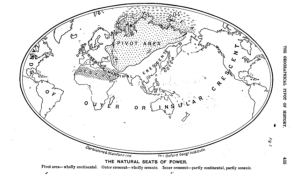Eurasianism (Russian: евразийство, yevraziystvo) is a socio-political movement in Russia that emerged in the early 20th century which states that there is a third unique continent between Europe and Asia dubbed "Eurasia", which belongs neither fully to Europe, or to Asia, comparable to Dimitri Kitsikis' "Intermediate Region".
In later iterations, this idea developed into a worldview in which a variety of unique interregional civilization-states, which do not operate through the ideas of the Western nation state, represent an alternative to the western "atlanticist" worldview, which seeks to arrange the whole world based on misconstrued "western" ideas, that the west itself deems "universal".
Geopolitical basis[edit | edit source]
Eurasianism draws heavily on 20th century Geopolitical doctrine. In particular that of Halford Mackinder, whose famous 1904 paper, "The Geographical Pivot of History," has been formative for geopolitical theorists from Zbigniew Brzezinski to Alexander Dugin. His paper was a landmark in conceiving geography in its relation to history, and examined the importance of the Eurasian Steppe in particular. In the context of Alfred-Thayer Mahan's The Influence of Sea Power Upon History, (1890) then at the height of its popularity, his paper could be seen as a response to over-hyped Anglos who thought they could rule the world from the waves alone. He writes about the great potential for railroads to crisscross Eurasia, rendering sea-shipping superfluous.
Who rules East Europe commands the Heartland: Who rules the Heartland commands the World Island: Who rules the World Island commands the world.[1]
